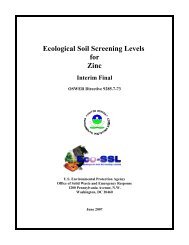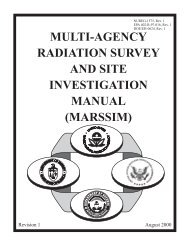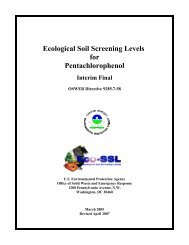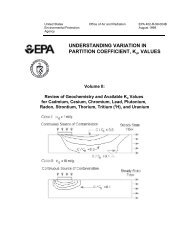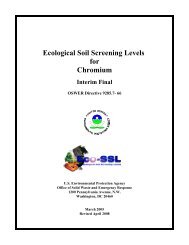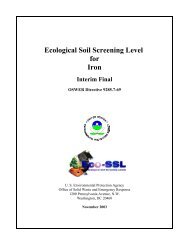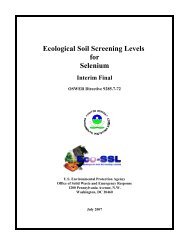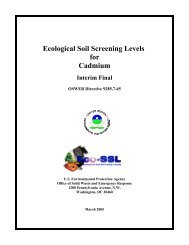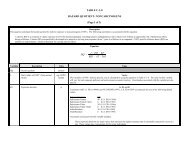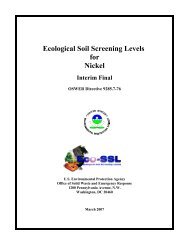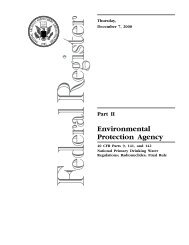- Page 1 and 2: BJC/OR-271 Guidance for Conducting
- Page 3 and 4: Guidance for Conducting Risk Assess
- Page 5 and 6: 5.1 COMPARISON TO RISK-BASED PRELIM
- Page 7 and 8: ACRONYMS ARARs Applicable or Releva
- Page 9 and 10: 1. INTRODUCTION The U.S. Department
- Page 11 and 12: Risk assessments and related risk a
- Page 13: Section 4: A more detailed discussi
- Page 17 and 18: Paducah Gaseous Diffusion Plant: Th
- Page 19 and 20: Site Evaluation Remedial Investigat
- Page 21 and 22: Removal Site Evaluation Removal Act
- Page 23 and 24: The results of these risk analyses
- Page 25 and 26: 3. OTHER ENVIRONMENTAL MANAGEMENT A
- Page 27 and 28: 3.3 TECHNOLOGY DEVELOPMENT AND DEMO
- Page 29 and 30: 4.1 DATA EVALUATION The first step
- Page 31 and 32: S. Department of Energy Oak Ridge Y
- Page 33 and 34: End Use Category Table 6. End Use W
- Page 35 and 36: database incorporates information n
- Page 37 and 38: Scenarios of Concern. Total noncarc
- Page 39 and 40: The guidelines in this document dic
- Page 41 and 42: 6. BASELINE HUMAN HEALTH RISK ASSES
- Page 43 and 44: Note: Remedial Goal Options (RGOs)
- Page 45 and 46: Spatial Anaysis and Decision Assist
- Page 47 and 48: EPA. 1991d. Appendix D of RAGS, Vol
- Page 49 and 50: APPENDIX A RISK ASSESSMENT TECHNICA
- Page 51 and 52: ES/ER/TM-28 The Use of Institutiona
- Page 53 and 54: spatially homogeneous, factors to a
- Page 55 and 56: ES/ER/TM-33/R2 by providing more sp
- Page 57 and 58: K/ER-153/R1 Baseline Risk Assessmen
- Page 59 and 60: Sections B.1 through B.5 provided i
- Page 61 and 62: evaluated by comparison to the repo
- Page 63 and 64: slope factor for 234 Th ( 234 Th do
- Page 65 and 66:
emaining analyses (since it had a l
- Page 67 and 68:
Analytes for which the maximum dete
- Page 69 and 70:
This guidance directs the user thro
- Page 71 and 72:
where: x = arithmetic mean of the b
- Page 73 and 74:
APPENDIX D GUIDE FOR AIR DISPERSION
- Page 75 and 76:
D.2 LAND USE—EXPOSURE SCENARIOS E
- Page 77 and 78:
Source Solidification/ Stabilizatio
- Page 79 and 80:
a certain depth of space. Two basic
- Page 81 and 82:
preclude the use of techniques for
- Page 83 and 84:
Technology-specific emission rates
- Page 85 and 86:
D-14 APPLICATION: Type Table D.4. S
- Page 87 and 88:
D-16 METEOROLOGY: RASCAL MILDOS- AR
- Page 89 and 90:
D.4.1.1 Screening-level codes D.4.1
- Page 91 and 92:
strongly recommended that external
- Page 93 and 94:
The primary difference between the
- Page 95 and 96:
1. source term 2. overland pathway
- Page 97 and 98:
Briggs, Klug, Brookhaven, St. Louis
- Page 99 and 100:
D-28 Table D.5. Atmospheric transpo
- Page 101 and 102:
D-30 Attributes CD M Table D.5. (co
- Page 103 and 104:
Only portions of the source area th
- Page 105 and 106:
D.4.2.2.3 CTDMPLUS The Complex Terr
- Page 107 and 108:
D.5. PARAMETERS The major input dat
- Page 109 and 110:
D.5.1.1.1 Wind directions In the va
- Page 111 and 112:
Table D.7. Meteorological data avai
- Page 113 and 114:
The EPA (1988) provides guidance on
- Page 115 and 116:
Input CAP88- PC Leafy Vegetables (K
- Page 117 and 118:
D.8. REFERENCES ANL (Argonne Nation
- Page 119 and 120:
Thibodeaux, L. J. 1989. Theoretical
- Page 121 and 122:
Table D.10. Baseline emission rate
- Page 123 and 124:
Table D.11. Remedial technologies t
- Page 125 and 126:
Table D.14. VOC emission rates for
- Page 127 and 128:
Title EPA and NTIS No. Date Estimat
- Page 129 and 130:
E.1 INTRODUCTION As one of the prim
- Page 131 and 132:
emedial decisions. Establishing a r
- Page 133 and 134:
Table E.2. Purpose of model selecti
- Page 135 and 136:
eview information from other simila
- Page 137 and 138:
its associated uncertainty, the tea
- Page 139 and 140:
E.4 REFERENCES Droppo, J. G., J. W.
- Page 141 and 142:
F.1 INTRODUCTION Human health risks
- Page 143 and 144:
F.2 PLANT MODELS For a complete ana
- Page 145 and 146:
Table F.1. (continued) Parameter De
- Page 147 and 148:
subsequently deposited on plant sur
- Page 149 and 150:
a major concern. F.2.1.2 Plant upta
- Page 151 and 152:
F.3 ANIMAL MODELS F.3.1 General Mod
- Page 153 and 154:
Table F.2. Recommended default valu
- Page 155 and 156:
f p = faction of the year the anima
- Page 157 and 158:
closely match the plant types of in
- Page 159 and 160:
consumption to a dry-weight basis b
- Page 161 and 162:
fat content of a cow (25%) and mult
- Page 163 and 164:
pasture, and dairy cattle obtain 60
- Page 165 and 166:
4.2.8 Fraction of daily water intak
- Page 167 and 168:
Hoffman, F. O., U. Bergstrom, C. Gy
- Page 169 and 170:
Peterson, H. T. ,. Jr.. 1983. Terre
- Page 171 and 172:
G.1. INTRODUCTION Calculation of th
- Page 173 and 174:
G.2.1 Soil Determining the size of
- Page 175 and 176:
Site Concentration 50 40 30 20 10 0
- Page 177 and 178:
Frequency Frequency Frequency 12000
- Page 179 and 180:
Stream G-11 Park Lake or River Figu
- Page 181 and 182:
More likely, contamination of sedim
- Page 183 and 184:
G.2.3 Groundwater The determination
- Page 185 and 186:
uncertainty analysis. G.2.4 Surface
- Page 187 and 188:
Figure G.12. ORNL groundwater risk
- Page 189 and 190:
G.2.4.1 Recommendations After selec
- Page 191 and 192:
G.3.2 Traditional Approach The firs
- Page 193 and 194:
G.3.3 Division of Data and the Bonf
- Page 195 and 196:
of giving smaller weights to areas
- Page 197 and 198:
Figure G.16. Variography of the exa
- Page 199 and 200:
5 Figure G.17. Kriged map of contam
- Page 201 and 202:
Northing 150 125 100 75 50 25 10 20
- Page 203 and 204:
concluded that the DL/2 method was
- Page 205 and 206:
The simulation presented in Sect. G
- Page 207 and 208:
By defining contamination boundarie
- Page 209 and 210:
Gilbert, R. 1987. Statistical Metho
- Page 211 and 212:
H.1. INTRODUCTION The quantitative
- Page 213 and 214:
(Andelman 1990) K p permeability co
- Page 215 and 216:
only (yr) 6 (child) (EPA 1991a) EF
- Page 217 and 218:
Table H.1. Uncertain parameters and
- Page 219 and 220:
values. These values are used in th
- Page 221 and 222:
Table H.4. Results of the uncertain
- Page 223 and 224:
and 12%, respectively) on the predi
- Page 225 and 226:
parameters that pertains to the adu
- Page 227 and 228:
While this methodology could be app
- Page 229 and 230:
EPA. 1991a. Risk Assessment Guidanc
- Page 231 and 232:
The first step in performing the in



